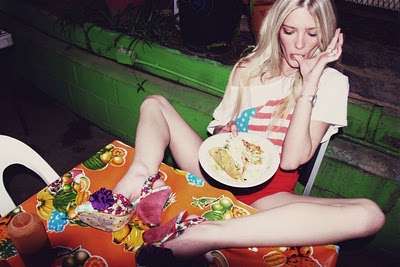I’ve been sugar-free for 16 days now. With a minuscule exception.** Huge. I’ve employed a range of tricks for quitting.
What’s been trickiest? Chocolate? Dessert? Nope. Breakfast.
Breakfast is dripping in sugar. Cereal, muesli, muffins, banana bread, fruit salad, yoghurt, jam, peanut butter. Even Promite!!! If you eat out or on the run, it’s worse. Try ordering even a porridge (in summer)… you have to specify no honey, no compote. And then it’ll come out drenched in low-fat yoghurt, which is brimful of sugar.
A tub of low-fat yoghurt (200ml) contains about 6-8 teaspoons of sugar. That stuff they serve at cafes? Even more…
Me, I’ve been mostly eating:
* poached eggs on toast, sometimes with bacon
* millet toast spread with cashew and turmeric spread from Suveran.
* avocado and vegemite on toast (gluten free)
* porridge “sweetened” with a little coconut milk and cinnamon, with yoghurt and nuts
* haloumi cheese grilled with sardines and olives
* smoothies made with a handful of frozen berries or a frozen banana…WHAT?! **Yes, bananas are full of sugar (berries are OK). But here’s the thing. My principles take over. I had 5 bananas in my freezer and given the shortage and given I don’t waste food ever (not even the stalks on spinach. Or sweet potato peel), I’ve been eating half at a time. My little bourgeouis experiment is not that important!
I’ve also been on the look-out for fruit and sugar-free muesli. I’ve posted a few below.
Other things to look out for:
* Chai tea – they often put honey or palm sugar in the mix
* drink full-fat milk with your coffee…the fat helps with sugar-cravings
* don’t drink juice. Veggie juice is ok, so long as it’s got no fruit juice in it (carrot and beetroot also contain a lot of sugar…be careful). A good substitute is coconut water.
* nuts are good! I eat a few after breakfast to curb the sugar grasp
But first.
I got David Gillespie, author of Sweet Poison, to share his thoughts:
Sugar avoidance can eliminate whole food groups, not just chocolate and ice-cream. Take a walk down the breakfast cereal aisle and you will be struggling to find a single product that doesn’t have significant amounts of sugar.
Breakfast can be an enormous source of sugar in a ‘healthy’ diet.
Eating a heart foundation approved cereal (like Kellogg’s Just Right) and a glass of apple juice for breakfast will add up to almost half a kilo of sugar by the end of the week.
That’s half a kilo of sugar in your diet before you even push back from the breakfast bowl, before you crack open a chocolate wrapper and before you tuck into an energy drink at morning tea time.
So what does the recovering sugarholic eat to start the day? Easy, we eat exactly what out grandparents ate for breakfast. Most sugary breakfast cereals didn’t exist before the second world war. Then people ate toast, porridge and cooked breakfasts.
Our grandparents had no trouble tucking into a big ol’ fryup of sausages, bacon (all bacon fat intact please) and eggs (and maybe a tomato for vegetable content). Or they whipped up a bit of bread and dripping (cooled, left-over animal fat) or maybe even a steaming hot bowl of porridge on cold winter mornings.
If you’re fresh out of dripping, then there’s nothing wrong with vegemite or even peanut butter on toast. Just check it is Vegemite and not the (much more sugary) competitors, Marmite or Promite (18 per cent sugar) and…
Make sure its a full fat peanut butter because the low-fat ones often have added sugar. Also, low-salt versions are better – more salt = more sugar.
Or you could go for one of my favourites, the Bacon and Egg sarny (as Jamie Oliver would say) on the way to the train.
Just make sure you don’t ruin smear it with BBQ sauce – it’s 55% sugar.
Don’t worry overly about the sugar content of the bread. Most breads (except raisin toast) have very little (if any) added sugar, but if you’re concerned, go for sourdough or rye. If you’re really feeling flush you can always go a bit Mediterranean and have a bit of crusty bread smeared with olive, garlic and tomatoes, with maybe a little cheese and prosciutto on top.
Her’s a bit of a cheat sheet …
|
Good |
Bad |
| Unflavoured Oats or Sugar (and fruit) free muesli’s | Most Breakfast Cereals |
| Unsweetened yoghurt with fresh berries (rather than fruit) | Sweetened Yoghurt (any yoghurt that tastes sweet) |
| Milk (preferably full fat), tea, coffee or water | Fruit salad, fruit juice or dried fruits |
| Toast with butter, vegemite, peanut butter, cheese, tomatoes or meat | Fruit toast and any sweet spread (like jams or honey) |
| Cooked breaky (just hold the sauce) |
And, finally, some muesli options:
1. David recommends Carmen’s Original fruit-free. He also rates Weet-Bix and Vita Brits (they’re very low in sugar). UPDATE: I’ve just noticed that Carmen’s is actually 8% sugar. A reader – Kate – also noticed the same. David has responded: “at the time the book went to press, that Muesli had 6.6% sugar and I said it was borderline unacceptable because of the honey. If its now higher (I know they have reformulated their fruit free bar to increase the sugar content, so maybe they have done the cereal as well) then its definitely a no go.
2. He also pointed this one out to me: The Muesli has created a delicious sugar free muesli, Fit for Breakfast.
3. And from Metabolic Food, a Superstart breakfast blend
Hope this helps! If you’ve recently quit…how are you getting around the breakfast problem?


